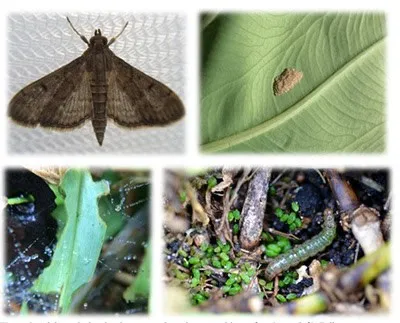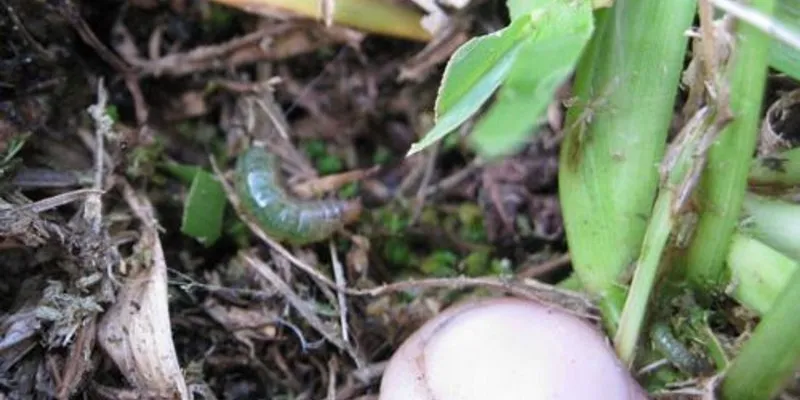Written by Adam Dale of the University of Florida IFAS Department
Fall is upon us already, and with that comes the peak of lawn caterpillar pest season. By now, most Gainesville landscape pest control professionals know to expect increased caterpillar pressure in North Florida lawns at the end of summer and arrival of fall. This has certainly held true in 2018, and as we have seen over the past few years, the biggest caterpillar turf pests are causing problems earlier in the year. This year, caterpillar outbreaks began showing up in late June in many areas of Alachua County.
The two biggest caterpillar pests of Florida turfgrasses are the tropical sod webworm and fall armyworm. These insects damage lawns by consuming leaf material above the rhyzome and stolon of turfgrass plants. It is important to remember that these pests are only damaging as caterpillars – that is when they have chewing mouthparts to consume plant tissue. Once the caterpillars complete their development, they turn into moths, which fly around feeding on nectar and depositing eggs on the grass or plant material adjacent to your lawn to re-start the life cycle (and lawn pest damage).
I frequently hear stories of homeowners leaving for a week and coming home to a completely eaten lawn. This recently happened to me, when I returned from an 8-day work trip to a lawn where half of the turf was eaten down to the St. Augustine grass stolons. Since this can happen rather quickly, it is critical that you scout plant material on a regular basis so that you catch the infestation before it becomes damaging.

Quick tips for monitoring for lawn caterpillars
- Watch for moth activity flying within the lawn and along shadier lawn margins
- Inspect light-colored surfaces or ornamental plant leaves adjacent to lawns for fall armyworm egg masses
- Watch for signs of young caterpillar feeding (window feeding) or more mature caterpillar damage (leaf notching) as pictured
- Scout for tropical sod webworms early in the morning when the dew is still on the grass (it will get caught in sod webworm webbing) as pictured
- Look in the thatch layer for green balls of caterpillar excrement. Tropical sod webworms leave behind green poop as they feed and are typically nearby as pictured above.
In addition to looking for those key indicators of an impending caterpillar infestation, you can also utilize the plants in the landscape. Although many people try to keep crabgrass out of their lawns, the reality is most people have crabgrass in their lawns. So, be aware of its location and take advantage of those weeds. Tropical sod webworms tend to prefer feeding on crabgrass. Therefore, in many cases, the path of lawn devastation begins in the crabgrass. Scout your crabgrass, looking for caterpillars or signs and symptoms that they are there, like those mentioned above. One great way to predict a webworm lawn invasion is if you notice a lot of “window feeding” or chewing damage on the crabgrass leaves. Once detected, this can give you enough lead time to treat and prevent the movement into your turfgrass and the subsequent damage, if handled rapidly.
Management strategies
Young, recently born insects are easiest to control with insecticides and cause the least damage. Fortunately, there are several insecticides that can be used to control webworm pests in your Gainesville lawn, several of which are highly selective for caterpillar pests with minimal non-target risks to beneficial organisms and the environment. These products include active ingredients like chlorantraniliprole, spinosad, and Bacillus thuringiensis. Specifically, my lab and others at the University of Florida have evaluated several products for controlling tropical sod webworms in lawns. We have found that the active ingredient, chlorantraniliprole, can provide over six weeks of greater than 80% control of tropical sod webworm caterpillars.
Turf and ornamental pest management always comes back to one thing: cultural practices. How is that plant or plant community being managed? One cultural pest control strategy that many pest or plant management professionals strive for is to identify and plant pest-resistant species or cultivars. That way, pests are not nearly as big of a concern. Unfortunately, fall armyworms and tropical sod webworms do not discriminate when it comes to feeding on warm-season turfgrass species.
Recent research
Unfortunately, pest-resistant plants are rarely an option. To overcome this, my lab has been investigating alternative strategies for preventing insect pest outbreaks in residential lawns. Instead of relying on pest-resistant plants, we are trying to figure out ways to generate host plant resistance using the turfgrass species and cultivars that are already available to us.
So far, we have found that planting multiple St. Augustinegrass cultivars in a mixture may provide benefits like pest-resistant plants. More specifically, we have found that fall armyworm caterpillars preferentially feed on turf cultivars planted with others of the same cultivar and tend to avoid plantings of four cultivars mixed together. For example, when presented with a choice of feeding on a stand of ‘Floratam’ or a stand of ‘Floratam’ mixed with ‘Palmetto’, ‘Bitterblue’, and ‘Classic’, most of the time it will feed on the ‘Floratam’ planted alone.
We have also seen other benefits, like reduced caterpillar feeding damage in mixed cultivar plantings compared to single cultivar plantings. Fall armyworms also mature to smaller individuals when they grow up feeding on mixed planting. We are currently continuing this work in large field plantings to see how other factors associated with lawns play out. Stay tuned for more details.
Helpful resources:
- Fall armyworm identification, biology, and management: http://edis.ifas.ufl.edu/in255
- Tropical sod webworm identification, biology, and management: http://edis.ifas.ufl.edu/in968
- Managing turfgrass insect pests: http://edis.ifas.ufl.edu/ig001
- Helpful, Harmful, Harmless - Insects and Other Organisms of Florida Landscapes: http://ifasbooks.ifas.ufl.edu/p-153-helpful-harmful-harmless.aspx
For updates on turf and ornamental entomology research from the University of Florida Lab, follow them on Twitter (@adamGdale) or on the web at https://dalelab.org
The Master's Lawn Care works with UF-IFAS to promote Integrated Pest Management in Lawns within our team, soil tests for pH and nutrient levels to develops programs for client lawns, and for training at their Pest Managment University in Apopka. If you have concerns about your Gainesville lawn pest control and are looking for a team to help you care for it in an ecologically-conservative manner, we are the team to call. Contact us via the form at the top of the page or by calling our office at (352) 378-5296.


